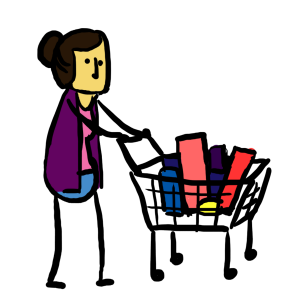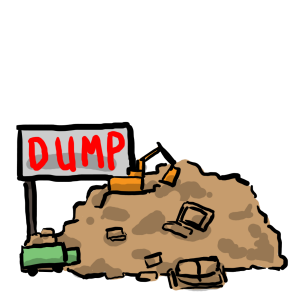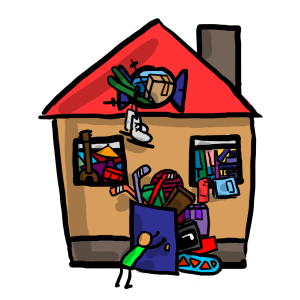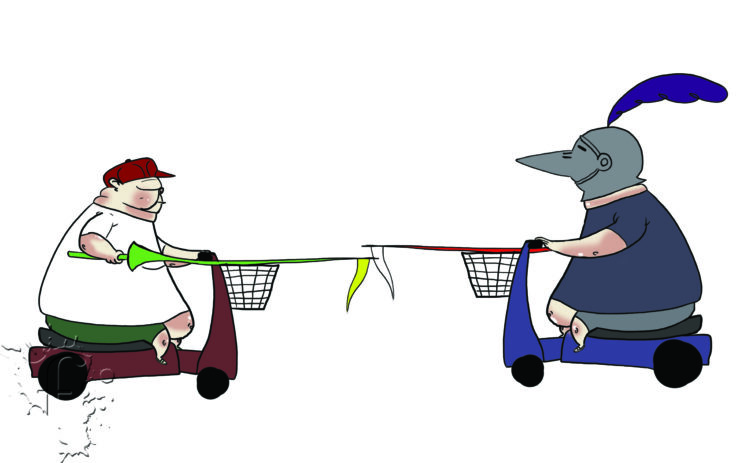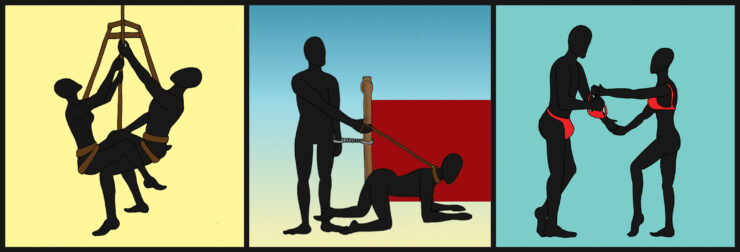Photo: Kim Wiens
Why consumer goods control our lives and what we’re doing to change this
Comedian George Carlin once said that a house is just a place to keep your stuff while you go out and get more stuff. What makes this bit so funny—like with most comedy—is that it’s not too far off from the truth.
This summer I got a front row seat to the real life equivalent of this standup routine when I was hired as a labourer for a moving company. While the work was straight forward, it still served as a stark reminder of how crazy and obsessive otherwise normal people can get when it comes to their material possessions.
With certain families I often felt like I was packing up their first-born into the moving truck, rather than their fancy leather sofa.
Other days I was just baffled by the sheer amount of useless junk that people hold on to. I can’t tell you the amount of times that I showed up to a job where I was expected to move a basement full of broken antiques, non-functioning electronics, and boxes of 40-year-old fashion magazines into a brand new house.
But hey, I don’t judge. After divorce or the death of a loved one, moving is one of life’s most stressful activities, primarily because people are forced to make some pretty hard-core decisions about the fate of their worldly belongings.
But why does the buying, storing, moving, and eventual disposal of stuff occupy such an important place in our lives? Better yet, is this obsession an economic issue or a psychological issue, or both?
Buy, burn, repeat
The origin of our obsession with stuff emerged in the wake of the Second World War, explains University of Ottawa marketing expert Michael Mulvey.
According to professor Mulvey, countries like Canada and the United States built up a robust production capacity during the war to keep the front lines well stocked, which translated into a booming post-war economy that forever changed the way we consume material goods.
“They were able to build things and sell things that were less attainable before and became more attainable (after),” said Mulvey, “whether that was an affordable, stylish car or using the ideas of production to develop homes in the suburbs.”
The ritual of shopping and consumerism became ingrained into many people’s daily routine, mostly because people felt like it was owed to them after enduring the hardships of wartime.
“In a way, it was a time to sort of celebrate, affirm, or retrench our core ‘American’ values, which had to do with (the narrative of) ‘work hard and reap the rewards’,” said Mulvey. “And so material goods were certainly a central part of that narrative.”
While the increased availability of refrigerators and vacuum cleaners made life a whole lot easier for the Betty Drapers of the world, several figures of influence and power took this idea a little too far.
In their minds, the key to cultivating a healthy, vibrant economy became dependent on the act of perpetual consumption itself, rather than encouraging the production of quality products.
Raymond J. Saulnier, the head of President Dwight Eisenhower’s Council of Economic Advisors, said “as I understand an economy, its ultimate purpose is to produce more consumer goods,” when he testified before congress in 1959.
Retail analyst Victor Lebow outlined an even more destructive model in the Journal of Retailing in 1955, stating that, in order to maintain a productive economy, “we need things consumed, burned up, worn out, replaced and discarded at an ever increasing pace.”
These kinds of sentiments largely influenced how goods are designed, produced, advertised, sold, and disposed for the remainder of the century and even today.
For example, while the manufacturing of sleek, boxy automobiles was the emblem of the healthy post-war boom, the quality of these cars took a dive once the swinging 60s came to an end.
“A lot of the cars that were being consumed or used in the 70s, they don’t exist anymore because they rusted away,” said Mulvey, crediting the decline of the North American muscle car to the use of cheap imported steel.
Modern electronics also ascribe to this buy, burn, repeat model, but for completely different reasons. Thanks to the influence of advertising and peer pressure, the constant cycle of buying of the latest iPhone or flat screen TV seems like an unbreakable necessity in the 21st century.
It’s also really hard to ignore wasteful behemoths like the fashion industry, which basically brow beats consumers into buying a new wardrobe every season.
Now that Canada is one of the worst waste producers in the world, it’s easy to see how the disposable nature of this economic model is taking its toll on the environment. According to a 2013 report released by the Conference Board of Canada, the Great White North dumps more garbage per capita than any other country in the developed world.
“Part of sustainability is not buying goods that are disposable,” said Mulvey. “Clearly, if you’re sending your goods off to be crushed after six years it is not a very good environmental model.”
Rise of the hipsters
Of course, it wasn’t always this way.
Frédérique Rivet, a U of O student and a coordinator for the Free Store, recalls a time when frugality and thrift was the name of the game.
“In my grandparents’ days they would reuse everything, but it was because of necessity. They could not afford to buy anything,” she said, alluding to the hardships of the Great Depression.
This old-school economic pragmatism seems to be making a comeback, mostly because today’s youth are facing tough economic conditions reminiscent of bygone days.
Not only do many economists describe the 2008 housing crisis as the worst of its kind since the Great Depression, but the lingering effects of this downturn have cast a long shadow on students looking to find financial stability in a post-graduate world. Even now Canada’s economy is on the precipice of a recession, having experienced nothing but negative growth for the last six months.
Second-year sociology student Marco Laberge realized he can’t adhere to traditional means of over consumption, especially in a world where underemployment, increased cost of living, and crippling student loan debt have become the norm. Instead, he opted to promote a lifestyle that champions less consumption and more selective purchases.
Laberge spreads this gospel through his blog on the philosophy of minimalism, something that he defines as “a tool to help you discover what is essential in your life.”
“Just take what you need, really,” he said offering examples to incoming students this mantra in action. “On the day-to-day grind, like waking up and going to class, you don’t need that many clothes. You can wear the same thing. No one will notice.”
For Rivet, her outlook on consumption comes to pass through her work at the university’s Free Store, where U of O students are invited to donate or pick up clothes, kitchenware, or school supplies without having to worry about the cost.
“People are just happy when they can find something really great that they would have bought for a $100 but they get it for free,” she said. “It makes them want to bring their stuff back to us even more.”
These attitudes are representative of the growing popularity of the “sharing economy”, where the capacity for people to rent, swap, or trade products or services is replacing the need for conventional ownership.
The advent of digital distribution on the Internet is a crucial factor in this socioeconomic phenomenon. It allows individuals to spontaneously sell and buy goods to a global audience, and eliminates the need for a build-up of physical goods.
While some members of the “old-guard” regard this economic shift as a tell-tale sign that this generation is cheap or immature, Mulvey disagrees. In his mind, modern tools like social media highlight the fact that young people today have adopted a better appreciation for their material goods.
“You can certainly see that a lot on Pintrest and social media networks, where people say ‘look at what I did with this incredibly puny space’. And so there’s a logic, there’s an appreciation for this minimalist aesthetic.”
Home is where the mess is
Despite the infectious optimism of students like Rivet and Laberge, there’s another dimension to our problem with stuff that transcends bad economic policies from the past.
While flagrantly disposing of perfectly usable electronics or clothing is costly and bad for the environment, hanging on to that same stuff forever can be much more harrowing on a personal level.
Not only does an excess of clutter in your personal space lead to stress, anxiety, and depression, according to a 2012 article published in Psychology Today it also inhibits your ability to problem solve and get your creative juices flowing.
Of course, nobody ever thinks of themselves as a compulsive hoarder, mostly because this kind of behaviour has been relegated to the “crazy” people that appear on sensationalized reality television.
In real life people who hoard stuff can be normal, everyday individuals who simply don’t have the time or skill set to keep their space neat and tidy.
“For a lot of my clients I would say that life gets in the way,” said Carolyn Kotva, an Ottawa professional organizer who runs her own local company called PackRat’s Professional Organizing. “They have other priorities and they don’t think about the stuff around them. They’ll just dump it in a room or just throw it to the side, leave it on the floor, because their mind is not focused on their surroundings.”
According to Kotva, emotional attachment and nostalgia also play a big role in why many of her clients cling to their useless junk.
“They’ll see an object and it’ll just bring back so many memories and they can’t bear to part with it,” she said.
According to Rivet, sometimes people even hoard for reasons beyond emotional attachment or rampant consumerism.
“It’s funny because I have a friend, it’s because he’s very environmentalist, and whenever you give him something…he’s like ‘Oh, I could find a use for it’. So he kind of hordes stuff,” she said. “His purpose is to find a use for it, but at the same time, what’s the point of keeping so much when you don’t actually do anything with them.”
While students like Rivet and Laberge do show promise with regards to conservative consumption, they still have their whole lives ahead of them—a life where advertising, nostalgia, and life acquisition rituals will constantly be pressuring them to dedicate much of their lives to buying and hanging onto stuff.
“It’s once you’ve had a house for twenty, thirty years, and you’ve had a lot of stuff accumulate in it, that’s when it becomes hard to let go,” said Laberge. “When you’re young like us, it’s a lot easier to let things go.”
Material dilemma
With their introductory year of university on the horizon, a new crop of students moving onto campus face a pretty complex dilemma with regards to the fate of their stuff.
Should they callously consume and dispose of their possessions like generations past and avoid the build up of clutter? Or, should they hang onto every single material possession in the hopes of reducing waste, at the risk of their own mental health?
Rivet has adopted her own operating model that fuses the two perspectives together.
“Yes, it’s okay to take stuff and to want stuff, but you have to be mindful of how much you take and how much you actually use, and to want to bring it back (to thrift stores) is the way we can keep going.”
Only time will tell whether or not Millennials can stay on this path of responsible purchasing and equally responsible disposal.
In the meantime, my fellow movers and I will continue to do our best to sort through this cultural paradigm through carrying your couches, tables, and china cabinets on our backs.
Pass the Rub A535.
Looking to donate or pick-up some used items this summer? Check out these fine locations that are all a stone’s throw away from campus!
Legend:
Books=green
Clothing=blue
Miscellaneous=yellow



